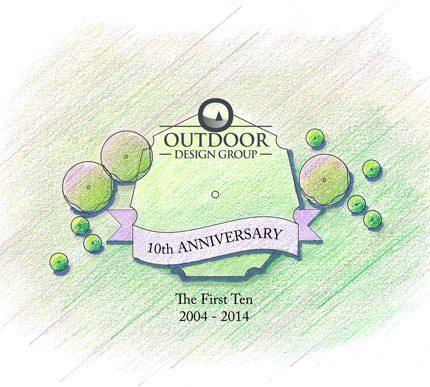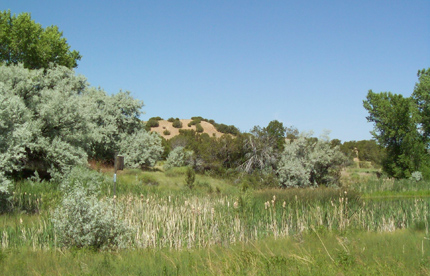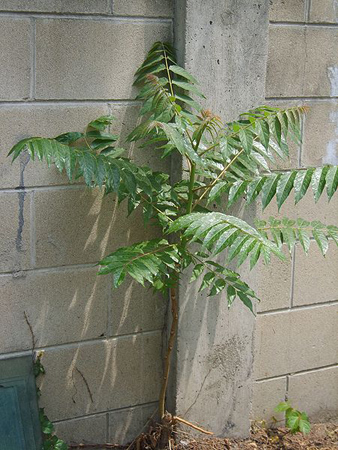by Matt Corrion

Ten years ago this month, I decided to venture out “on my own” to form Outdoor Design Group, Inc. working out of my house in the Highlands neighborhood of Denver – It was the best move I’ve ever made.
A decade later, I couldn’t be prouder of all that this business has achieved. From small residential gardens, to large commercial projects and housing developments, our list of completed projects is impressive by any measure. We have also stayed true to the values that I started with: hard work, honesty, integrity and outstanding customer service.
We’ve designed projects that have been built in the real world, not just imagined on paper but touched by hands and crafted through stone, earth, water, and living plants. Along the way we’ve bettered the environment by creating sustainable landscapes that conserve water and resources. And we have added value for our clients and have created quality places in our neighborhoods and communities.
But the best part of the last 10 years has been the lasting relationships that have been built- especially those with our customers. There is nothing more satisfying than helping someone create their dream landscape or helping to fulfill their life’s ambitions through our part in their project.
I would like to thank my wife, Amanda for sticking by my side from the beginning when I came up with the crazy idea to start a business. Without your encouragement and support we never would have survived those early years! Last but not least, over the last several years as our team has grown I’ve had the pleasure of working with some of the most dedicated employees, consultants, and contractors one could ever ask for. Our work could not be completed without your hard work and dedication – Thank you very much!
This is the official blog of Outdoor Design Group, Colorado Landscape Architects. For more information about our business and our services, click here.
Related Posts:
by Todd Rutherford
As gardeners in Colorado may well know, our climate and altitude make for challenging growing conditions. This doesn’t mean we are completely immune from invasive exotic plants making an unwelcome home here. We do not have the burden that gardeners in wetter and warmer states may have at stopping the spread of invasive plants, but there are a few species you should be aware of so you can help stop these unwanted guests from gaining a foothold in our landscapes.
Why be concerned about invasive plants? They crowd out native plants, propagate uncontrollably, and may reduce forage for wildlife. Some may have a negative impact on your garden plants. And research suggests that some invasive species may pose dangers to humans through the increased risk of flooding due to damaged waterways, or increased fire danger.
The two worst invasive woody plants for Colorado and the surrounding region are the Russian Olive and the Tamarisk. Russian Olive (Elaeagnus angustifolia), is native to western and central Asia. It was introduced into North America in the latter part of the 1800’s. It is not related to true olive plants (Olea europaea) but its fruit is edible but not very palatable for human consumption. It out competes native plants because its seeds are irresistible to birds which spread the seeds far and wide. The seeds have a low mortality rate, germinate readily in poor soil (it can fix its own nitrogen in its roots), reach maturity quickly and thus outcompete native plants. In Colorado, they often begin setting a foothold in riparian areas, and then spread from there.

Russian Olives invading a wetland in New Mexico.
Tamarisk (Tamarix ramosissima), which is more of a shrub than a tree, similarly starts its spread in the riparian areas of the Colorado and other southwestern states. It has been such a successful invader of wet areas, that it has overtaken huge sections of the rivers of the southwest. However, it is not as tolerant of cold temperatures as is Russian Olive, which restricts its spread to the warmer, lower elevations of the southwest. Tamarisk is tolerant of many soil types, and thrives in full sun. One of the concerns about Tamarisk’s effect on native landscapes is how they out compete native vegetation, altering the nutrient cycles of riparian areas. They also consume large amounts of water, and secrete large amounts of salt, both items further slowing the success of nearby native plants. A massive amount of resources and manpower are being directed at the fight to stop the spread of this plant through the wildlands of the desert southwest.
…the Siberian Elm is “one of, if not the, world’s worst trees…a poor ornamental that does not deserve to be planted anywhere”.
Closer to Denver and the urban areas of Colorado’s front range, there are two trees that are common pests. These are the Siberian Elm (Ulmus pumila), and the Tree of Heaven (Ailanthus altissima). Both of these trees release a profuse amount of seeds, and these seeds are very adept at sprouting in disturbed areas. They proliferate along transportation corridors and abandoned lots. Both trees prefer full sun, but Ailanthus can tolerate some shade allowing it to invade some mature native forests.

Young Ailanthus altissima
Although not directly related, Ailanthus trees (a.k.a. Tree of Heaven) are often mistaken as sumacs. In springtime they produce many flowers that have a foul odor which some say is similar to cat urine. It rapidly out competes other tree species, releasing an allelopathic chemical which inhibits the growth of other plants. Some researchers have extracted this chemical from Ailanthus trees, successfully using it as an herbicide. Not only is this tree toxic to other plants, there have been anecdotal reports of it being slightly toxic to humans and livestock. Ailanthus trees can grow quite rapidly, leading to weak, unstable branches.
Siberian Elms also have structural problems, with many weak or dead branches that can break off in heavy wind. Siberian elms have a short dormancy period which leads to early flowering in spring, and late leaf drop in fall. In Colorado that means they can become dangerously loaded with wet snow in our common heavy spring snowstorms, or the occasional fall snowstorm, leading to heavy branches falling on roofs and vehicles. In addition to the dangers of breaking limbs, the trees do not have a very favorable appearance, with an awkward branching pattern. One doesn’t need to search too long before you find many Siberian elm seedlings sprouting up in unwanted spots in the urban landscape. The sprouts show up in shrub beds where they are difficult to remove by hand and hard to spray with herbicides without damaging neighboring desired plant materials. Siberian elms are susceptible to damage from elm leaf beetles which leave the leaves looking skeletonized, but it doesn’t seem to kill the trees. Notable horticulturalist Michael Dirr says the Siberian Elm is “one of, if not the, world’s worst trees…a poor ornamental that does not deserve to be planted anywhere”.
To be fair, I should mention that some people look favorably upon these four tree species, and say that in Colorado’s high desert climate (that is naturally and predominantly tree-less east of the Rocky Mountains), an invasive tree is better than no tree, especially in urban areas. I would beg to differ, noting that these trees are too difficult to control and remove, to the detriment of native flora and fauna. Please become aware of these invasive trees and be considerate about whether you want to allow these in your landscape.
This is the official blog of Outdoor Design Group, Colorado Landscape Architects. For more information about our business and our services, click here.
Related Posts:




